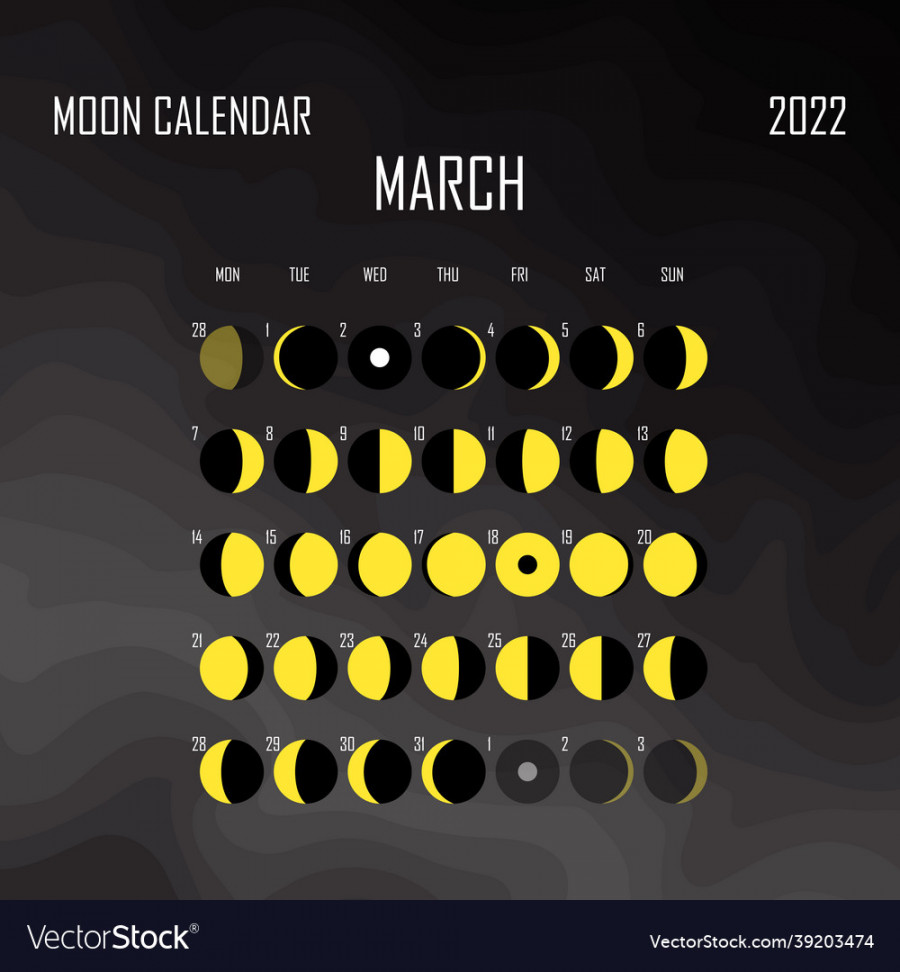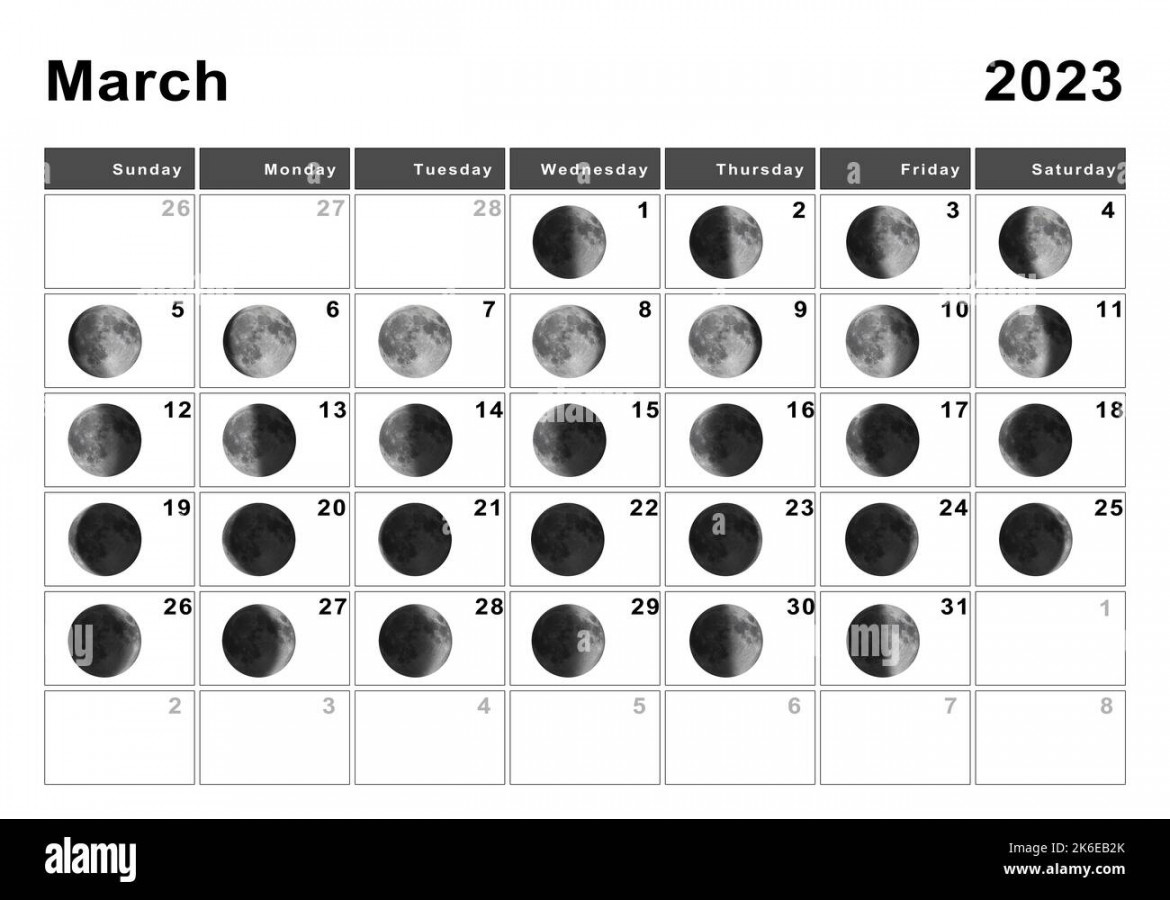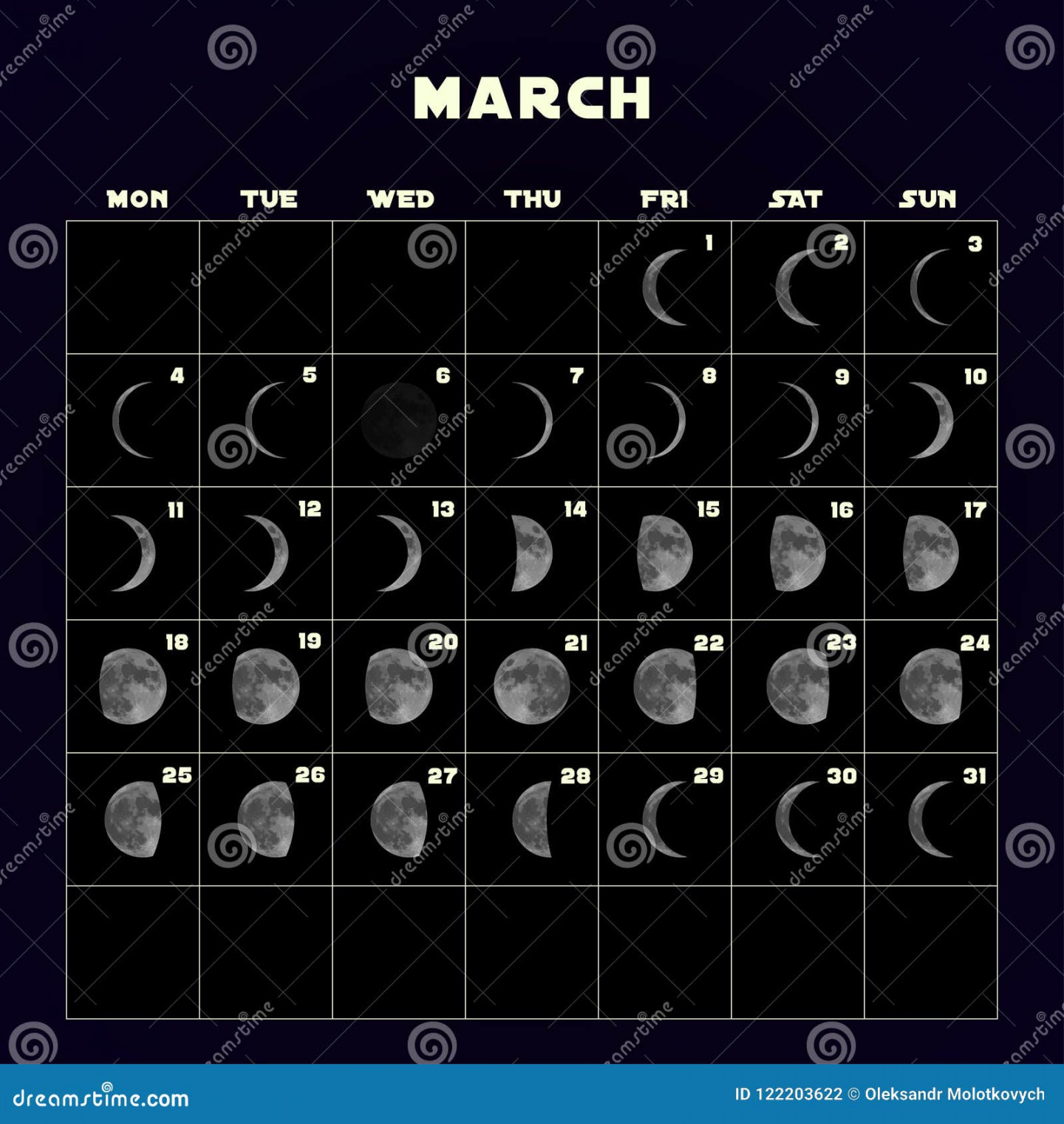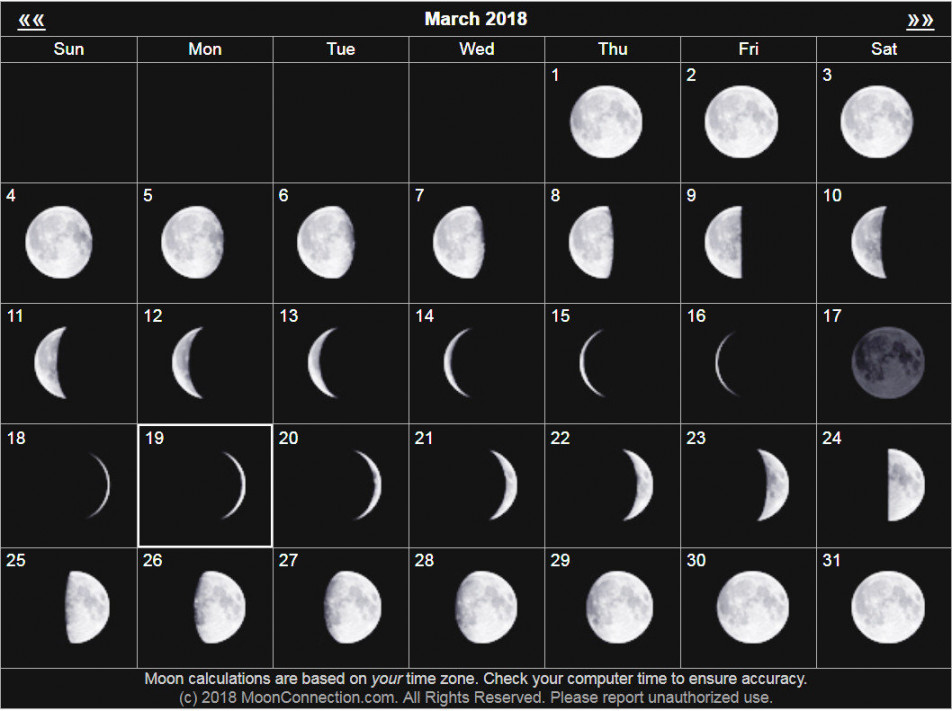Moon Phases In March
Behold, Your New Moon Calendar For 2023
Every 29.5 days, give or take, the moon falls perfectly in line with the sun, rendering it invisible to stargazers, insomniacs, and astrology devotees alike here on Earth. To the average person, this period of three or so days each month might be easy to ignore—out of sight, out of mind. But for those in tune with the moon, and aware of the power it has to impact your everyday life, the new moon is a recurring astrological event that deserves a mark on your calendar.
For those who don’t already observe each new moon like it’s a national holiday, you might be asking: Why is this phase of a lunation so important? Well, it’s all about a fresh start. “You can think of the new moon as a monthly reset or rebirth, where [it] disappears from the night sky, then reappears a few days later as a waxing crescent,” says the team at CHANI, an astrological app founded by professional astrologer Chani Nicholas. “There is a quality of emergence and curiosity during a new moon—but it may take awhile for your plans and ideas to find their form.”
Generally speaking, each new moon can be an opportunity to both reflect on the past cycle and start a new one—but not all new moons are created equal. Because a new moon occurs when the sun and moon are aligned, the moon will always be in the same sign that the sun is in. This means that each and every new moon will come with its own set of unique characteristics, and you’ll want to take note of the astrological season in order to truly harness the full power and potential of Mother Luna.
Another reason the new moon is so powerful: It’s the only lunar phase during which a solar eclipse can happen. And yes, this is definitely something you’ll want to mark your calendar for, too, but more on that in a bit.
Here is a look at the 12 new moons of 2023, and how to best tap into each moon’s astrological energy to make your year magical.
When is the next new moon?New Moon in Scorpio – Monday, November 13 at 4:27 a.m. EST
Because Scorpio is a feelings-fueled water sign, “Scorpio new moons can stir up tender emotions and memories. Cue the moody playlists and Dear Diary confessionals,” the CHANI team says. “This is a moment to patiently parse through feelings, but remember none of them are final.”

When was the last new moon?New Moon Solar Eclipse in Libra – Saturday, October 14 at 1:55 p.m. EST
“This is the first eclipse of its kind in Libra that we’ve had for nearly twenty years,” explains the CHANI team. This one will focus on themes of letting go: “On the sacrificial altar? People pleasing, unhealthy codependencies, and any relationship pattern where you consistently center another person’s needs before your own.”
Upcoming New Moon of 2023New Moon in Sagittarius – Tuesday, December 12 at 6:32 a.m. EST
Ah, yes, the last new moon of 2023. What can you expect? And how can you best observe its energy? “Sagittarius new moons pack big ‘don’t fence me in’ energy. This is a time to let loose with your far-roaming plans,” says the CHANI team. “Travel mentally or physically and prioritize the books, podcasts, or projects that stretch your horizons.”

New Moon in Virgo – Thursday, September 14 at 9:40 p.m. EST
“Virgo new moons prioritize care by tending to the details, so organize your bookshelf. Deep-clean your home. Polish your candlesticks. Not because you ‘should,’ but because you deserve a pristine temple or sanctuary,” says the team at CHANI.
Virgos will feel at home during this new moon, and for the less organized signs (hi, Aries besties), this is the perfect time to tap into that much needed Earth energy.
New Moon in Leo – Wednesday, August 16 at 5:38 a.m. EST
Leo, Leo, Leo—the center of attention. You gotta love her. “Leo new moons are all about strutting your stuff, and taking selfies while doing so,” says the CHANI team. “Whether you express yourself through your art, your statement jewelry, or your famous bake sale carrot cake, this is a time to radiate your uniqueness.”

New Moon in Cancer – Monday, July 17 at 2:32 p.m. EST
“The moon is at home in Cancer, so Cancer new moons are especially sweet and fertile for new beginnings. Cast your spells accordingly,” says the CHANI team. “Note that your intuition can be heightened at this time, so you might experiment with divination or dream interpretation.”
This new moon could be the perfect time to carry out a candle ritual focused on manifestation, or break out your moon water for a little scrying practice.
New Moon in Gemini – Sunday, June 18 at 12:37 a.m. EST
“Gemini new moons inspire flurries of ideas and the urge to chase each one. These lunations tend to be fun and flirty—but not necessarily focused,” according to the CHANI team. Coming from a Gemini, that’s so Gemini.
To make the most of this scattered, chaotic energy, there are a few things you can do. “Keep a record of all your flashes of inspiration, but remember you can’t tackle them all at once,” the CHANI team suggests.
New Moon in Taurus – Friday, May 19 at 11:53 a.m. EST
Fun fact: This is the first new moon in Taurus that hasn’t been paired with a solar eclipse. “That alone is a reason to celebrate,” says the CHANI team. “Traditionally, [the moon] is considered exalted in this sign, which means the soil is extra fertile for setting intentions. Nurture that project, relationship, or idea that you want to grow from the ground up.”
While this new moon is the perfect time to plant seeds of intention, May is also the ideal month for sowing literal seeds. Celebrate the onset of summer by viewing your garden, or houseplants, as physical representations of your manifestations.

New Moon Solar Eclipse in Aries – Thursday, April 20 at 12:12 a.m. EST
“The sun represents our vitality, our ego selves, and our sense of authority,” explains the CHANI team. “When the sun’s light gets blocked during a solar eclipse, it can feel like an ego bruise, or like our sense of authority gets challenged or dented. It can also be a time when our systems feel run down or ragged.”
This may sound a tad scary, but solar eclipses aren’t all bad. The solar eclipse that takes place during the April new moon, for example, has its perks.
“The first eclipse along the new sign axis, this moment marks the beginning of a fresh chapter in our lives. It will activate our hunger and urge us to tackle all projects at once,” says the CHANI team. “As eclipse protocol would dictate, it may be wise to take a deep breath (or ten) and reconsider whether or not the opportunity before you is a wise way to spend your energy.”
New Moon in Aries – Tuesday, March 21 at 1:23 p.m. EST
“Aries new moons are fiery and action-oriented,” says the CHANI team. “This is a moment to take healthy risks, such as starting a new business or sharing your grand plans with a potential collaborator.”
It’s important to note that the moon can be a little bit of a trickster, so don’t let the energy in the air lead you astray. “The [warning sign of] this lunation is the idea that you can or should go it alone. Remember, no one is self-made,” says the team at CHANI.
New Moon in Pisces – Monday, February 20 at 2:06 a.m. EST
“Pisces new moons are dreamy, intuitive, and inspired. This time is ripe for escaping into your imaginal and creative realms,” the CHANI team says. Phew. All that logical, methodical thinking can be set aside… for now. With the Pisces new moon, the goal is “to let your imagination inspire your reality, rather than neglect it altogether,” says the team at CHANI.
New Moon in Aquarius – Saturday, January 21 at 3:53 p.m. EST
Utilizing the power of the moon is often a time to let your creativity run rampant, but the first new moon of the year is a chance to let your left brain do the work for once. “Aquarius new moons tend to be more detached and analytical, helping us assess the data and weigh potential pros and cons,” says the CHANI team. “Just remember that feelings offer valuable information, too.”
What is a “Black Moon”?
For starters, to understand what a “Black Moon” is, you have to first get acquainted with its equally elusive twin sister: The “Blue Moon.” (Psst, the moon doesn’t actually appear in the color blue, btw, but wouldn’t that be awesome?)
As mentioned, the orbital period of the moon is almost exactly a month—29.5 days, give or take, to be more specific. Occasionally, you may get 13 full moons in a year or four full moons per season, according to Jason Steffen, PhD, an astrophysicist and associate professor of physics at the University of Nevada, Las Vegas.
The original definition of the Blue Moon was if one season has four full moons, the third full moon out of that season is considered the Blue Moon, says Steffen. But that definition has evolved over time, causing some astronomers and astronomy enthusiasts alike to adopt a new meaning: “The Blue Moon is the second full moon in a single calendar month,” per Steffen. For example, let’s say there is a full moon on March 1, 2024 and then another one on March 29, 2024. The March 29 full moon would be the Blue Moon, says Steffen.
If you’re confused, don’t worry. Per Steffen, both definitions of the Blue Moon are widely accepted—the one you choose to follow is merely a matter of personal preference.
The Black Moon shares the same dual-meaning, “except that instead of the moon being in the full phase, it’s the moon being in the new phase,” says Steffen. TL;DR: The Black Moon is the third new moon in a single season that has four new moons. Or, it’s the second new moon within a single calendar month. It all depends on which definition you choose to follow.
When is the next Black Moon?
If you’ve never heard of a Black Moon, it’s probably because it’s such a rare occurrence. A Black Moon happens about once every two or three years, per Steffen. To be more specific, once every 33 months (2.75 years) or 29 months (2.4 years) according to what definition you follow, per Time and Date.
If you missed the Black Moon in Taurus that happened on May 19, 2023 (er, if you follow the OG meaning), don’t fret—you have a few more chances within the next two years to catch this rare lunar event.
If you follow the alternative definition of a Black Moon, which is the second new moon in a single month, the next Black Moon will occur on December 30, 2024. But if you follow the original definition (the third new moon in a single season), you’ll have to wait until August 22, 2025 to catch the Black Moon, according to Steffen.
What are the different moon phases?
ICYDK, the moon goes through eight distinct moon phases when transitioning from one new moon to the next. Ahead, Steffen outlines the different phases of the moon and how to tell them apart.
The eight phases of the moon.
artpartner-images//Getty ImagesNew Moon: In the new moon phase, you can’t see the moon at all from Earth’s vantage point, says Steffen. It’s darkened hemisphere is facing the Earth, rendering it invisible. The only instance in which you can see the new moon is during a solar eclipse, which is when the moon passes directly in front of the sun, per Steffen. Waxing Crescent: This is the first transitional moon phase, per Steffen. Here, the moon appears crescent-shaped as direct sunlight begins to hit the side of the moon viewed from Earth. Crescent moons are most visible during the day as well as slightly before sunrise or after sunset, according to Steffen. First Quarter: This is the first exact moon phase after the new moon, per Steffen. It’s called a “quarter moon” because a quarter of the moon is actually illuminated, although it appears that half of the moon is lit up when viewing it from Earth—the right side from Earth’s POV. Here, the moon is 90 degrees away from the sun. Waxing Gibbous: In this phase, the moon is more than halfway illuminated, says Steffen. Unlike the crescent moons, the gibbous moons are most visible throughout the middle of the night. “They won’t be visible during the day really,” other than for a bit after sunset, Steffen adds. Full Moon: “The full moon rises right as the sun is setting,” and is fully illuminated, per Steffen. Here, the moon is 180 degrees away from the sun. When the sun, Earth, and the moon are perfectly aligned—the planet’s shadow crossing the face of the moon—you get a lunar eclipse. Waning Gibbous: More than half of the moon is illuminated, but on the opposite side from the waxing gibbous—starting left to right versus right to left from Earth’s point-of-view. The amount of sunlight hitting the moon slowly decreases as it moves into the last quarter. Last Quarter: This is the last exact moon phase before the moon goes back to its new moon starting position, per Steffen. Similar to the first quarter, half of the visible moon is illuminated but this time the sun is shining on the other half—the left side from Earth’s POV. Waning Crescent: This is the last transitional phase of the moon, per Steffen. Less than half of the moon appears illuminated—the left side from Earth’s vantage point—as it moves back into the new moon phase and the cycle begins again.
Do you have your manifestation journal and tarot deck ready? Great! Cause the upcoming new moon energy is sure to shake up your world.
Aliza Pelto (she/her) is a rurally raised, NYC-based writer, Gemini, and iced coffee enthusiast. Her work has appeared with The National Organization for Women, Alma, and both in print and online at BUST Magazine. When she’s not reading, recording her podcast (Little Sleep//Much Reading), or doing something witchy, you can find her dissociating via TikTok for hours on end.
Assistant Editor
Naydeline Mejia is an assistant editor at Women’s Health, where she covers sex, relationships, and lifestyle for WomensHealthMag.com and the print magazine. She is a proud graduate of Baruch College and has more than two years of experience writing and editing lifestyle content. When she’s not writing, you can find her thrift-shopping, binge-watching whatever reality dating show is trending at the moment, and spending countless hours scrolling through Pinterest.